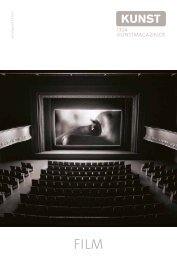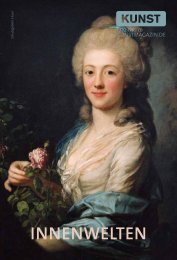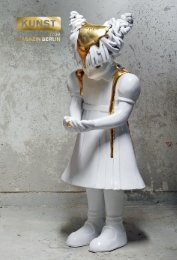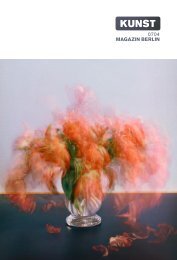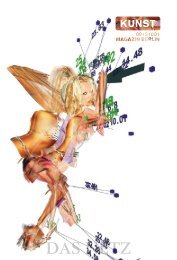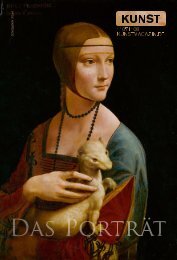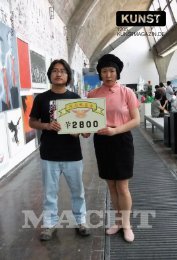Download als .pdf - KUNST Magazin
Download als .pdf - KUNST Magazin
Download als .pdf - KUNST Magazin
Sie wollen auch ein ePaper? Erhöhen Sie die Reichweite Ihrer Titel.
YUMPU macht aus Druck-PDFs automatisch weboptimierte ePaper, die Google liebt.
Internationales Sammlergespräch<br />
Patrizia Sandretto Re Rebaudengo & Francesco Bonami<br />
Conversations with Collectors:<br />
Patrizia Sandretto Re Rebaudengo & Francesco Bonami<br />
Übersetzung: Julika Nehb<br />
Patrizia Sandretto Re Rebaudengo sammelt seit den<br />
frühen 1990er-Jahren zeitgenössische Kunst und<br />
gründete 1995 die Stiftung „Fondazione Sandretto<br />
Re Rebaudengo“ in Turin, deren Präsidentin sie ist.<br />
Künstlerischer Leiter der Stiftung ist Francesco<br />
Bonami, der u. a. 2003 die Sektion Visual Arts der<br />
Biennale von Venedig leitete. Das Gespräch wurde<br />
von Jan Kage moderiert und fand am 27.4. im me<br />
Collectors Room/Stiftung Olbricht statt.<br />
Patrizia, du hast vor über 20 Jahren angefangen,<br />
Kunst zu sammeln. Heute bist du Kunstmäzenin, du<br />
unterstützt junge Künstler, du kooperierst mit internationalen<br />
Museen. Was war der Auslöser für deinen<br />
Wunsch, Kunst zu sammeln?<br />
P.S.R.R.: Es bereitet mir einfach sehr viel Freude! In<br />
meiner Kindheit war ich umgeben von der Porzellansammlung<br />
meiner Mutter, die mich aber gelang<br />
Text: Julika Nehb, Elisabeth Braunshier,<br />
Annabell Manz<br />
Patrizia Sandretto Re Rebaudengo has been collecting<br />
contemporary art since the early 1990s. In 1995 she<br />
founded the “Fondazione Sandretto Re Rebaudengo”<br />
and she serves as its president. The artistic director of the<br />
foundation is Francesco Bonami, who <strong>als</strong>o directed the<br />
section of Visual Arts at the Biennale in Venice in 2003.<br />
The Conversation was moderated by Jan Kage and took<br />
place on the 27th of April at the ‘me’ Collectors Room<br />
of the Olbricht Founation.<br />
Patrizia, you started to collect art more than 20 years<br />
ago. Today, you are a patron of the arts. You support<br />
young artists, and you collaborate with international<br />
museums. What sparked your desire to collect art?<br />
P.S.R.R.: I started to collect contemporary art because of<br />
the joy it gave me. I grew up surrounded by my mother’s<br />
collection of porcelain figurines. The porcelain was always<br />
boring to me because it did not talk to me. I was always<br />
weilt hat – nichts hat mich wirklich angesprochen.<br />
Ich habe mich aber schon immer gefragt, was hinter<br />
der Kunst steckt. Ich wollte an den Entwicklungsprozessen<br />
im Hintergrund teilhaben. 1992 fuhr ich<br />
mit einem befreundeten Kunstsammler nach London.<br />
Wir besuchten Galerien, und ich lernte viele<br />
Künstler kennen. Ich hatte die Gelegenheit, mich mit<br />
großartigen Menschen zu unterhalten, habe einfach<br />
sehr viel gelernt. Dieses Erlebnis hat mich wirklich<br />
verändert. Dam<strong>als</strong> fing ich an, britische Kunst zu<br />
sammeln. Gleichzeitig wuchs mein Interesse an zeitgenössischer<br />
italienischer Kunst und auch an Kunst<br />
von Frauen.<br />
Wie hast du Francesco kennengelernt, und seit wann<br />
arbeitet ihr zusammen?<br />
F.B.: Das war ein Zufall. 1995 organisierte ich<br />
eine Fotografieausstellung in Venedig und hatte<br />
Schwierigkeiten, ein paar Rechnungen zu bezahlen.<br />
Jedenfalls dachte ich, dass meine Probleme durch<br />
Geld verursacht wurden – ich hatte ja keine Ahnung,<br />
dass mit Patrizia die Schwierigkeiten erst anfingen!<br />
Wir wurden einander vorgestellt, und seither<br />
arbeiten wir zusammen.<br />
P.S.R.R.: Wir sind fast immer zusammen und<br />
diskutieren sehr viel. Francesco ist ein fantastischer<br />
Mensch. Unsere Gespräche sind das Fundament für<br />
die Sammlung. Als ich anfing zu sammeln, wurde<br />
mir sehr schnell klar, dass das Kaufen allein mich<br />
nicht ausfüllen würde. Ich wollte den Kontakt zu<br />
den Künstlern.<br />
Wie muss man sich eure Zusammenarbeit vorstellen?<br />
F.B.: Nun ja, Patrizia entscheidet, denn sie muss ja<br />
auch bezahlen. Ich sage ihr, was eine gute Arbeit ist,<br />
und sie kauft es dann. In der Regel kaufen wir, weil<br />
uns etwas gefällt, und nicht weil berühmte Namen<br />
mit der Arbeit verbunden sind.<br />
Was ist das Geheimnis einer guten Sammlung? Der<br />
Spiegel deines persönlichen Geschmacks? Oder gibt<br />
es eine bestimmte Haltung, nach der du suchst?<br />
F.B.: Eine gute Sammlung ist mit einer guten<br />
Ausstellung vergleichbar. Man sollte sich nicht<br />
darüber Sorgen machen, ob man richtig liegt oder<br />
politisch korrekt ist. Man muss sich mit seiner<br />
Sammlung identifizieren können.<br />
P.S.R.R.: Genau. Ich folge meinem Instinkt und hoffe<br />
einfach, dass meine Entscheidungen Sinn machen.<br />
Ich habe noch nie ein Kunstwerk gekauft, weil ich<br />
dachte, dass das fantastisch in meinem Wohnzimmer<br />
aussehen würde! Der Austausch mit den Künstlern<br />
und zwischen Francesco und mir ist mir unglaublich<br />
wichtig. Zeitgenössische Kunst ist mein Leben – ich<br />
kann mir nicht vorstellen, ohne meine Sammlung<br />
oder meine Kunst zu sein.<br />
Was war das erste Kunstwerk, das du gekauft hast,<br />
und wie nimmst du es heute wahr?<br />
curious about what is behind the art. I wanted to get<br />
involved, and I really wanted to participate. In 1992, I went<br />
to London with a friend of mine who is <strong>als</strong>o a collector. We<br />
visited some galleries and I met a lot of artists. I had so<br />
many great conversations and just learned so much – it<br />
really changed my mind. That was when I started to collect<br />
British art. But I <strong>als</strong>o grew interested in contemporary<br />
Italian art, and got involved with women’s art.<br />
How did you meet Francesco, and since when are the<br />
two of you working together?<br />
F.B.: We met by chance. In 1995 I was organizing a<br />
photography exhibition in Venice, where I had some<br />
trouble paying the bills. Well, at least I thought that<br />
the trouble was money. I did not know that the trouble<br />
would be Patrizia! Somebody introduced us, and that<br />
was the beginning of our relationship. Since then we<br />
have been doing shows together.<br />
P.S.R.R.: We never separate. We are discussing things all<br />
the time. Francesco is fantastic. By talking and discussing<br />
we created and still create the collection. When I started<br />
to collect, just buying art was not enough for me. I<br />
wanted to be more involved with the artists.<br />
How do you work together?<br />
F.B.: Well, Patrizia has to make the final decisions,<br />
because she has to pay. So I tell her that something<br />
is a good work and she buys it. We mostly buy works<br />
because we like them rather than just because of some<br />
famous names.<br />
What is the secret behind a good collection? Is it just<br />
a reflection of personal taste? Is there a certain kind of<br />
attitude you look for?<br />
F.B.: A good collection is like a good exhibition. You<br />
should not worry about being right or politically correct.<br />
You have to identify with your collection.<br />
P.S.R.R: Yes. I follow my instinct and I just hope that<br />
it makes sense. I never bought a work of art because it<br />
would look fantastic in my living room. The dialogue with<br />
the artists and the exchange between Francesco and me is<br />
so important to me. Contemporary art is my life. I can not<br />
imagine living without my collection or my artists.<br />
What was the first piece of art that you bought, and<br />
how do you perceive it now?<br />
P.S.R.R.: The first pieces I bought were two works from<br />
Anish Kapoor. And I bought two works by Tony Cragg.<br />
One is in my home. And one was by Allen McCollum,<br />
which is now in my dining room. I really enjoy living<br />
with my art.<br />
(Question from the audience) Does it make sense to buy<br />
art in places other than London, New York or Berlin?<br />
F.B.: You can buy art anywhere you want. But there<br />
is definitely the tendency today to buy art as an<br />
investment, and there is a lot of speculation. So mostly,<br />
people buy in markets that have a strong infrastructure.<br />
I mean you buy German cars and not Uzbekistan cars.<br />
16 SAMMLERGESPRÄCH<br />
SAMMLERGESPRÄCH 17



